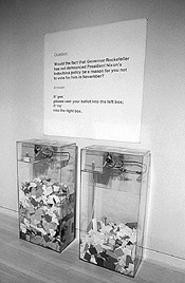The premise of this show is that an artist can be both a minimalist and a social activist. Nothing earth-shattering about that, but when one remembers that minimalism prizes elementary shapes, outsized scale, and a cool industrial appearance, the question is: How does one reconcile this impersonality with the warm-blooded urge to right wrongs in the world? The answer that the artists in this exhibit give is that maybe the formal rigors of minimalism can be used to discipline and channel social messages. Combining politics with minimalism, under these circumstances, doesn't require the expertise of a Dr. Frankenstein. Any artist might successfully do it, as long as he is clear about what he wants to say and whom he wants to reach. Success at this kind of art (according to those who practice it) has little to do with the art's physical qualities (shape, surface texture, materials) and a lot to do with whether it encourages viewers to think, feel, and draw conclusions, rather than accept them. Unfortunately, in this show, one is often encouraged not to think, feel, and draw conclusions, but rather to accept the artists' prepackaged thoughts.
Take Adrian Piper's "Black Box/White Box" from 1992. This work consists of two large-scale cubes, one painted black and the other white, that, by virtue of their shape and size, recall other large-scale minimal objects from the '60s. As one enters the white cube through an opening at the side, one sees a comfortable chair. As the viewer sits down, he sees a TV screen in front of him that, over and over again, shows the excruciating 81-second video of Rodney King being beaten up by members of the Los Angeles Police Department. Meanwhile, over a loudspeaker can be heard the voice of then-President Bush saying that "what we saw here last night (referring to riots that resulted from the incident) was not about civil rights . . . It's been the brutality of a mob, pure and simple." After sitting in the white box awhile, one goes to the black box and sits in the chair there. Here, one looks not at a TV screen but at a mirror. One listens not to the president over the loudspeaker but rather the voice of King saying, "We can all get along here." Hanging over the chair is a framed picture of President Bush greeting some L.A. police officers in happier times.
This is manipulative art. Granted, the work makes no pretense at being value-free; it unashamedly vilifies the LAPD and paints Bush as a moron (that "pure and simple" is priceless; there is nothing pure and simple about mob psychology, as the experience of the German people under Hitler has shown us). It also pits King's simple language against Bush's more polished presidential tones to emphasize the class and economic differences between them. But how can one take work like this seriously, when it treats the president and Rodney King as cardboard cutout figures rather than human beings?
Another problem with the work is that the video footage practically blots out the other point that Piper is presumably trying to make. So strong is its literal impact that viewers don't have a chance to develop their own interpretations about what they're seeing on the screen. The artwork seems to suggest that all of us are implicated in events such as the King beating (hence, the mirror), but we're less likely to believe it when we are so aware of being manipulated into thinking that.
One gets the same feeling from the work of Mary Kelly, who deals with atrocities that have occurred in war-torn Lebanon. Kelly uses lint, collected from a clothes dryer, to form fragments of text that describe subjects such as cluster bombs, submunitions, and dart grenades, and the terrible things they do. Her work is politically committed, but preachy.
By contrast, Hans Haacke, in his effective "MoMA Poll" (1970), is a political minimalist with a difference. To the purely formal qualities of repetition and deadpan presentation, along with the expected political charge, he has added something unexpected -- a dash of humor. In this piece, Haacke offered viewers to the Museum of Modern Art the chance to vote on the question "Would the fact that Governor Rockefeller has not denounced President Nixon's Indochina policy be a reason for you not to vote for him in November?" By dropping their ballots in the Plexiglas ballot boxes, the voters determined what the object's political message would be. The yeas won 25,567 to 11,563. The witty touch is the phrasing of the question. It's full of negatives and, consequently, it's tough to decipher on first reading. It recalls the ambiguous speech patterns perfected by Nixon's press secretary Ron Ziegler to throw off the media. Haacke is creating a piece of serious political art, but he's also poking fun at the way politicians, pollsters, and press secretaries talk.
The portion of the exhibit devoted to a videotape of dancer and choreographer Yvonne Rainer is also compelling. Rainer, a pupil of Martha Graham's, was one of the most innovative figures on the American art scene during the '60s. Her work was about gender politics and femininity, and the video hones in on this. The movements are by turns languid and full of tensile strength. Rainer interrupts a sequence by appearing to wash her hair or sit down on a nonexistent chair. As she once noted, she was "constantly engaged in transitions" as she danced. Since she was not interested in making any part of a dance more important than any other, all the movements became equally expressive. Everyday gestures thus could be charged with new meaning. Some performance instructions are included along with the videotape, photographs, and other items documenting Rainer's impact. These highlight her sense of the absurd. Indeed, Rainer, at one point, instructs her dancers: "You may here indulge in any involuntary sounds engendered by your performance -- such as grunts, squeaks, "whoops,' etc."
Robert Morris helped define minimalism in the 1960s through his sculptures and theoretical writings. His "Untitled" (1965) is a set of four cubic blocks covered with mirrors, and the idea here is that the images reflected in the mirrors change depending on where one is standing in relation to them. The political implications might have something to do with accepting shifts in perspective: As one moves around these objects or shares the space with other people, the mirrors catch new reflections. One cannot move the cubes, but one does have control over one's actions. This conceptually clean work is a classic of first-generation minimalism. Also interesting is a videotape of a Morris work that features a nude man and woman covered in oil and shuffling slowly in a close embrace along parallel wooden tracks while accompanied by a woman in an oversized man's suit and hat. The video seems to be about relationships, but it's unclear what is going on. The deliberate pace gives one the sense that something important is happening, but the task performed by the man and woman is ridiculous, so one is back at square one. This work is like a puzzle that resists a solution.
Although the new exhibit at the Center for Contemporary Art proves that some politically engaged minimalists have not yet found a way to merge topical subject matter with rich examination of same, it also includes the work of artists who expand minimalism in interesting ways. Rainer and Haacke demonstrate what can happen when absurdity and humor are added to the political/minimal mix. Morris, meanwhile, is inscrutable but also provocative. Overall, the show is uneven but well worth seeing.











